6.4: Three Dimensional Cake Baking
( \newcommand{\kernel}{\mathrm{null}\,}\)
In the rest of the chapter we will extend our studies to three dimensional problems. In this section we will solve the heat equation as we look at examples of baking cakes.
We consider cake batter, which is at room temperature of T_{i}=80^{\circ} \mathrm{F}. It is placed into an oven, also at a fixed temperature, T_{b}=350^{\circ} \mathrm{F}. For simplicity, we will assume that the thermal conductivity and cake density are constant. Of course, this is not quite true. However, it is an approximation which simplifies the model. We will consider two cases, one in which the cake is a rectangular solid, such as baking it in a 13^{\prime \prime} \times 9^{\prime \prime} \times 2^{\prime \prime} baking pan. The other case will lead to a cylindrical cake, such as you would obtain from a round cake pan.
This discussion of cake baking is adapted from R. Wilkinson’s thesis work. That in turn was inspired by work done by Dr. Olszewski,(2006) From baking a cake to solving the diffusion equation. American Journal of Physics 74(6).
Assuming that the heat constant k is indeed constant and the temperature is given by T(\mathbf{r}, t), we begin with the heat equation in three dimensions,
\frac{\partial T}{\partial t}=k \nabla^{2} T \text {. }\label{eq:1}
We will need to specify initial and boundary conditions. Let T_{i} be the initial batter temperature, T(x, y, z, 0)=T_{i}.
We choose the boundary conditions to be fixed at the oven temperature T_{b}. However, these boundary conditions are not homogeneous and would lead to problems when carrying out separation of variables. This is easily remedied by subtracting the oven temperature from all temperatures involved and defining u(\mathbf{r}, t)=T(\mathbf{r}, t)-T_{b}. The heat equation then becomes
\frac{\partial u}{\partial t}=k \nabla^{2} u\label{eq:2}
with initial condition
u(\mathbf{r}, 0)=T_{i}-T_{b} .\nonumber
The boundary conditions are now homogeneous. We cannot be any more specific than this until we specify the geometry.
We will consider a rectangular cake with dimensions 0 \leq x \leq W, 0 \leq y \leq L, and 0 \leq z \leq H as show in Figure \PageIndex{1}. For this problem, we seek solutions of the heat equation plus the conditions
\begin{aligned} u(x, y, z, 0) &=T_{i}-T_{b}, \\ u(0, y, z, t)=u(W, y, z, t) &=0, \\ u(x, 0, z, t)=u(x, L, z, t) &=0, \\ u(x, y, 0, t)=u(x, y, H, t) &=0 . \end{aligned} \nonumber
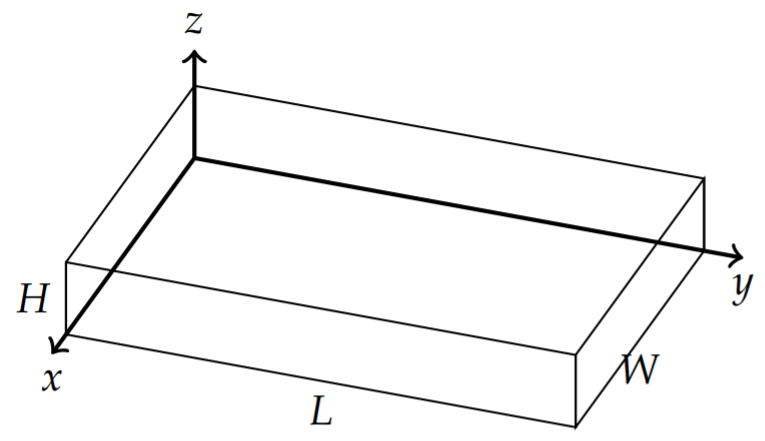
Solution
Using the method of separation of variables, we seek solutions of the form
u(x, y, z, t)=X(x) Y(y) Z(z) G(t) .\label{eq:3}
Substituting this form into the heat equation, we get
\frac{1}{k} \frac{G^{\prime}}{G}=\frac{X^{\prime \prime}}{X}+\frac{Y^{\prime \prime}}{Y}+\frac{Z^{\prime \prime}}{Z} .\label{eq:4}
Setting these expressions equal to -\lambda, we get
\frac{1}{k} \frac{G^{\prime}}{G}=-\lambda \quad \text { and } \quad \frac{X^{\prime \prime}}{X}+\frac{Y^{\prime \prime}}{Y}+\frac{Z^{\prime \prime}}{Z}=-\lambda\label{eq:5}
Therefore, the equation for G(t) is given by
G^{\prime}+k \lambda G=0 .\nonumber
We further have to separate out the functions of x, y, and z. We anticipate that the homogeneous boundary conditions will lead to oscillatory solutions in these variables. Therefore, we expect separation of variables will lead to the eigenvalue problems
\begin{align} X^{\prime \prime}+\mu^{2} X &=0, & X(0) &=X(W)=0,\nonumber \\ Y^{\prime \prime}+v^{2} Y &=0, & Y(0) &=Y(L)=0,\nonumber \\ Z^{\prime \prime}+\kappa^{2} Z &=0, & Z(0) &=Z(H)=0 .\label{eq:6} \end{align}
Noting that
\frac{X^{\prime \prime}}{X}=-\mu^{2}, \quad \frac{Y^{\prime \prime}}{Y}=-v^{2}, \quad \frac{Z^{\prime \prime}}{Z}=-\kappa^{2},\nonumber
we find from the heat equation that the separation constants are related,
\lambda^{2}=\mu^{2}+v^{2}+\kappa^{2} .\nonumber
We could have gotten to this point quicker by writing the first separated equation labeled with the separation constants as
\underbrace{\frac{1}{k} \frac{G^{\prime}}{G}}_{-\lambda}=\underbrace{\frac{X^{\prime \prime}}{X}}_{-\mu}+\underbrace{\frac{Y^{\prime \prime}}{Y}}_{-v}+\underbrace{\frac{Z^{\prime \prime}}{Z}}_{-\kappa} .\nonumber
Then, we can read off the eigenvalues problems and determine that \lambda^{2}=\mu^{2}+v^{2}+ \kappa^{2}.
From the boundary conditions, we get product solutions for u(x, y, z, t) in the form
u_{m n \ell}(x, y, z, t)=\sin \mu_{m} x \sin v_{n} y \sin \kappa_{\ell} z e^{-\lambda_{m n} k t},\nonumber
for
\lambda_{m n l}=\mu_{m}^{2}+v_{n}^{2}+\kappa_{\ell}^{2}=\left(\frac{m \pi}{W}\right)^{2}+\left(\frac{n \pi}{L}\right)^{2}+\left(\frac{\ell \pi}{H}\right)^{2}, \quad m, n, \ell=1,2, \ldots\nonumber
The general solution is a linear combination of all of the product solutions, summed over three different indices,
u(x, y, z, t)=\sum_{m=1}^{\infty} \sum_{n=1}^{\infty} \sum_{\ell=1}^{\infty} A_{m n l} \sin \mu_{m} x \sin v_{n} y \sin \kappa_{\ell} z e^{-\lambda_{m n} k t},\label{eq:7}
where the A_{\text {mn }} ’s are arbitrary constants.
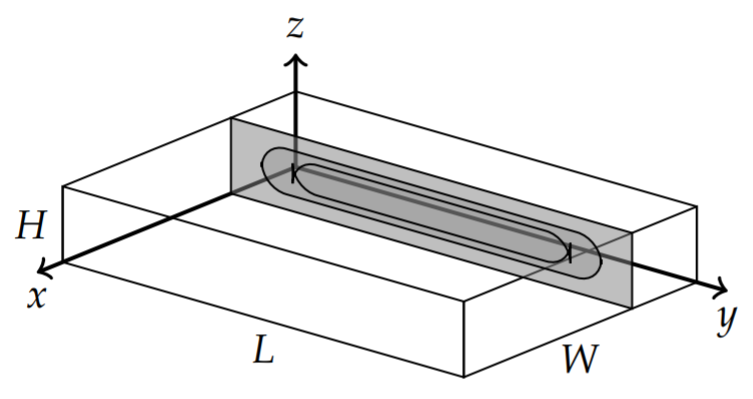
We can use the initial condition u(x,y,z,0)=T_i-T_b to determine the A_{mn\ell}'s. We find
\label{eq:8}T_i-T_b=\sum\limits_{m=1}^\infty\sum\limits_{n=1}^\infty\sum\limits_{\ell =1}^\infty A_{mnl}\sin\mu_m x\sin v_ny\sin k_{\ell} z.
This is a triple Fourier sine series.
We can determine these coefficients in a manner similar to how we handled double Fourier sine series earlier in the chapter. Defining
b_m(y,z)=\sum\limits_{n=1}^\infty\sum\limits_{\ell =1}^\infty A_{mnl}\sin v_ny\sin k_{\ell}z,\nonumber
we obtain a simple Fourier sine series:
T_i-T_b=\sum\limits_{m=1}^\infty b_m(y,z)\sin\mu_mx.\label{eq:9}
The Fourier coefficients can then be found as
b_m(y,z)=\frac{2}{W}\int_0^W (T_i-T_b)\sin\mu_mxdx.\nonumber
Using the same technique for the remaining sine series and noting that T_i − T_b is constant, we can determine the general coefficients A_{mnl} by carrying out the needed integrations:
\begin{aligned}A_{mnl}&=\frac{8}{WLH}\int_0^H\int_0^L\int_0^W (T_i-T_b)\sin\mu_m x\sin v_ny\sin k_{\ell}zdxdydz \\ &=(T_i-T_b)\frac{8}{\pi^3}\left[\frac{\cos\left(\frac{m\pi x}{W}\right)}{m}\right]_0^W \left[\frac{\cos\left(\frac{n\pi y}{L}\right)}{n}\right]_0^L \left[\frac{\cos\left(\frac{\ell\pi z}{H}\right)}{\ell}\right]_0^H \\ &=(T_i-T_b)\frac{8}{\pi^3}\left[\frac{\cos m\pi -1}{m}\right]\left[\frac{\cos n\pi -1}{n}\right]\left[\frac{\cos\ell\pi -1}{\ell}\right] \\ &=(T_i-T_b)\frac{8}{\pi^3}\left\{\begin{array}{ll} 0,&\text{for at least one }m,n,\ell\text{ even,} \\ \left[\frac{-2}{m}\right]\left[\frac{-2}{n}\right]\left[\frac{-2}{\ell}\right],&\text{for }m,n,\ell\text{ all odd.}\end{array}\right.\end{aligned} \nonumber
Since only the odd multiples yield non-zero A_{mn\ell} we let m=2m'-1, n=2n'-1, and \ell =2\ell '-1 for m',n',\ell '=1,2,\ldots. The expansion coefficients can now be written in the simpler form
A_{mn}=\frac{64(T_b-T_i)}{(2m'-1)(2n'-1)(2\ell '-1)\pi ^3}.\nonumber
Substituting this result into general solution and dropping the primes, we find
u(x,y,z,t)=\frac{64(T_b-T_i)}{\pi^3}\sum\limits_{m=1}^\infty\sum\limits_{n=1}^\infty\sum\limits_{\ell =1}^\infty \frac{\sin\mu_m x\sin v_ny\sin k_{\ell}ze^{-\lambda_{mnt}kt}}{(2m-1)(2n-1)(2\ell -1)},\nonumber
where
\lambda_{m n \ell}=\left(\frac{(2 m-1) \pi}{W}\right)^{2}+\left(\frac{(2 n-1) \pi}{L}\right)^{2}+\left(\frac{(2 \ell-1) \pi}{H}\right)^{2}\nonumber
for m, n, \ell=1,2, \ldots . .
Recalling that the solution to the physical problem is
T(x, y, z, t)=u(x, y, z, t)+T_{b},\nonumber
we have the final solution is given by
T(x, y, z, t)=T_{b}+\frac{64\left(T_{b}-T_{i}\right)}{\pi^{3}} \sum_{m=1}^{\infty} \sum_{n=1}^{\infty} \sum_{\ell=1}^{\infty} \frac{\sin \hat{\mu}_{m} x \sin \hat{v}_{n} y \sin \hat{\kappa}_{\ell} z e^{-\hat{\lambda}_{m n \ell} k t}}{(2 m-1)(2 n-1)(2 \ell-1)}\nonumber
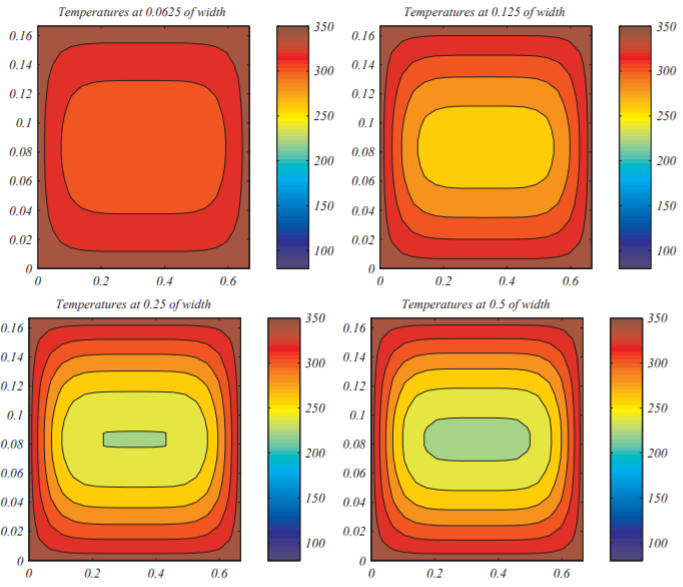
We show some temperature distributions in Figure \PageIndex{3}. Since we cannot capture the entire cake, we show vertical slices such as depicted in Figure \PageIndex{2}. Vertical slices are taken at the positions and times indicated for a 13^{\prime \prime} \times 9^{\prime \prime} \times 2^{\prime \prime} cake. Obviously, this is not accurate because the cake consistency is changing and this will affect the parameter k. A more realistic model would be to allow k = k(T(x, y, z, t)). However, such problems are beyond the simple methods described in this book.
In this case the geometry of the cake is cylindrical as show in Figure \PageIndex{4}. Therefore, we need to express the boundary conditions and heat equation in cylindrical coordinates. Also, we will assume that the solution, u(r, z, t)=T(r, z, t)-T_{b}, is independent of \theta due to axial symmetry. This gives the heat equation in \theta independent cylindrical coordinates as
\frac{\partial u}{\partial t}=k\left(\frac{1}{r} \frac{\partial}{\partial r}\left(r \frac{\partial u}{\partial r}\right)+\frac{\partial^{2} u}{\partial z^{2}}\right),\label{eq:10}
where 0 \leq r \leq a and 0 \leq z \leq Z. The initial condition is
u(r, z, 0)=T_{i}-T_{b},\nonumber
and the homogeneous boundary conditions on the side, top, and bottom of the cake are
\begin{array}{r} u(a, z, t)=0, \\ u(r, 0, t)=u(r, Z, t)=0 . \end{array}\nonumber
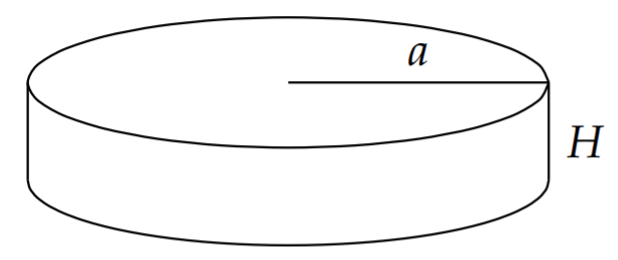
Solution
Again, we seek solutions of the form u(r, z, t)=R(r) H(z) G(t). Separation of variables leads to
\underbrace{\frac{1}{k} \frac{G^{\prime}}{G}}_{-\lambda}=\underbrace{\frac{1}{r R} \frac{d}{d r}\left(r R^{\prime}\right)}_{-\mu^{2}}+\underbrace{\frac{H^{\prime \prime}}{H}}_{-v^{2}} .\label{eq:11}
Here we have indicated the separation constants, which lead to three ordinary differential equations. These equations and the boundary conditions are
\begin{align} G^{\prime}+k \lambda G &=0,\nonumber \\ \frac{d}{d r}\left(r R^{\prime}\right)+\mu^{2} r R &=0, \quad R(a)=0, \quad R(0) \text { is finite, }\nonumber \\ H^{\prime \prime}+v^{2} H &=0, \quad H(0)=H(Z)=0 .\label{eq:12} \end{align}
We further note that the separation constants are related by \lambda=\mu^{2}+v^{2}.
We can easily write down the solutions for G(t) and H(z),
G(t)=A e^{-\lambda k t}\nonumber
and
H_{n}(z)=\sin \frac{n \pi z}{Z}, \quad n=1,2,3, \ldots,\nonumber
where v=\frac{n \pi}{Z}. Recalling from the rectangular case that only odd terms arise in the Fourier sine series coefficients for the constant initial condition, we proceed by rewriting H(z) as
H_{n}(z)=\sin \frac{(2 n-1) \pi z}{Z}, \quad n=1,2,3, \ldots\label{eq:13}
with v=\frac{(2 n-1) \pi}{Z}.
The radial equation can be written in the form
r^{2} R^{\prime \prime}+r R^{\prime}+\mu^{2} r^{2} R=0 .\nonumber
This is a Bessel equation of the first kind of order zero which we had seen in Section 5.5. Therefore, the general solution is a linear combination of Bessel functions of the first and second kind,
R(r)=c_{1} J_{0}(\mu r)+c_{2} N_{0}(\mu r) .\label{eq:14}
Since R(r) is bounded at r=0 and N_{0}(\mu r) is not well behaved at r=0, we set c_{2}=0. Up to a constant factor, the solution becomes
R(r)=J_{0}(\mu r) .\label{eq:15}
The boundary condition R(a)=0 gives the eigenvalues as
\mu_{m}=\frac{j_{0 m}}{a}, \quad m=1,2,3, \ldots,\nonumber
where j_{0 m} is the m^{\text {th }} roots of the zeroth-order Bessel function, J_{0}\left(j_{0 m}\right)=0.
Therefore, we have found the product solutions
H_{n}(z) R_{m}(r) G(t)=\sin \frac{(2 n-1) \pi z}{\mathrm{Z}} J_{0}\left(\frac{r}{a} j_{0 m}\right) e^{-\lambda_{n m} k t},\label{eq:16}
where m=1,2,3, \ldots, n=1,2, \ldots. Combining the product solutions, the general solution is found as
u(r, z, t)=\sum_{n=1}^{\infty} \sum_{m=1}^{\infty} A_{n m} \sin \frac{(2 n-1) \pi z}{Z} J_{0}\left(\frac{r}{a} j_{0 m}\right) e^{-\lambda_{n m} k t}\label{eq:17}
with
\lambda_{n m}=\left(\frac{(2 n-1) \pi}{\mathrm{Z}}\right)^{2}+\left(\frac{j_{0 m}}{a}\right)^{2},\nonumber
for n, m=1,2,3, \ldots.
Inserting the solution into the constant initial condition, we have
T_{i}-T_{b}=\sum_{n=1}^{\infty} \sum_{m=1}^{\infty} A_{n m} \sin \frac{(2 n-1) \pi z}{\mathrm{Z}} J_{0}\left(\frac{r}{a} j_{0 m}\right) .\nonumber
This is a double Fourier series but it involves a Fourier-Bessel expansion. Writing
b_{n}(r)=\sum_{m=1}^{\infty} A_{n m} J_{0}\left(\frac{r}{a} j_{0 m}\right),\nonumber
the condition becomes
T_{i}-T_{b}=\sum_{n=1}^{\infty} b_{n}(r) \sin \frac{(2 n-1) \pi z}{Z} .\nonumber
As seen previously, this is a Fourier sine series and the Fourier coefficients are given by
\begin{aligned} b_{n}(r) &=\frac{2}{Z} \int_{0}^{Z}\left(T_{i}-T_{b}\right) \sin \frac{(2 n-1) \pi z}{Z} d z \\ &=\frac{2\left(T_{i}-T_{b}\right)}{Z}\left[-\frac{Z}{(2 n-1) \pi} \cos \frac{(2 n-1) \pi z}{Z}\right]_{0}^{Z} \\ &=\frac{4\left(T_{i}-T_{b}\right)}{(2 n-1) \pi} \end{aligned} \nonumber
We insert this result into the Fourier-Bessel series,
\frac{4\left(T_{i}-T_{b}\right)}{(2 n-1) \pi}=\sum_{m=1}^{\infty} A_{n m} J_{0}\left(\frac{r}{a} j_{0 m}\right),\nonumber
and recall from Section 5.5 that we can determine the Fourier coefficients A_{n m} using the Fourier-Bessel series,
f(x)=\sum_{n=1}^{\infty} c_{n} J_{p}\left(j_{p n} \frac{x}{a}\right),\label{eq:18}
where the Fourier-Bessel coefficients are found as
c_{n}=\frac{2}{a^{2}\left[J_{p+1}\left(j_{p n}\right)\right]^{2}} \int_{0}^{a} x f(x) J_{p}\left(j_{p n} \frac{x}{a}\right) d x .\label{eq:19}
Comparing these series expansions, we have
A_{n m}=\frac{2}{a^{2} J_{1}^{2}\left(j_{0 m}\right)} \frac{4\left(T_{i}-T_{b}\right)}{(2 n-1) \pi} \int_{0}^{a} J_{0}\left(\mu_{m} r\right) r d r .\label{eq:20}
In order to evaluate \int_{0}^{a} J_{0}\left(\mu_{m} r\right) r d r, we let y=\mu_{m} r and get
\begin{align} \int_{0}^{a} J_{0}\left(\mu_{m} r\right) r d r &=\int_{0}^{\mu_{m} a} J_{0}(y) \frac{y}{\mu_{m}} \frac{d y}{\mu_{m}}\nonumber \\ &=\frac{1}{\mu_{m}^{2}} \int_{0}^{\mu_{m} a} J_{0}(y) y d y\nonumber \\ &=\frac{1}{\mu_{m}^{2}} \int_{0}^{\mu_{m} a} \frac{d}{d y}\left(y J_{1}(y)\right) d y\nonumber \\ &=\frac{1}{\mu_{m}^{2}}\left(\mu_{m} a\right) J_{1}\left(\mu_{m} a\right)=\frac{a^{2}}{j_{0 m}} J_{1}\left(j_{0 m}\right) .\label{eq:21} \end{align}
Here we have made use of the identity \frac{d}{d x}\left(x J_{1}(x)\right)=J_{0}(x) from Section 5.5.
Substituting the result of this integral computation into the expression for A_{n m}, we find
A_{n m}=\frac{8\left(T_{i}-T_{b}\right)}{(2 n-1) \pi} \frac{1}{j_{0 m} J_{1}\left(j_{0 m}\right)} .\nonumber
Substituting this result into the original expression for u(r, z, t), gives
u(r, z, t)=\frac{8\left(T_{i}-T_{b}\right)}{\pi} \sum_{n=1}^{\infty} \sum_{m=1}^{\infty} \frac{\sin \frac{(2 n-1) \pi z}{Z}}{(2 n-1)} \frac{J_{0}\left(\frac{r}{a} j 0 m\right) e^{-\lambda_{m m} k t}}{j_{0 m} J_{1}\left(j_{0 m}\right)} .\nonumber
Therefore, T(r, z, t) is found as
T(r, z, t)=T_{b}+\frac{8\left(T_{i}-T_{b}\right)}{\pi} \sum_{n=1}^{\infty} \sum_{m=1}^{\infty} \frac{\sin \frac{(2 n-1) \pi z}{Z}}{(2 n-1)} \frac{J_{0}\left(\frac{r}{a} j_{0 m}\right) e^{-\lambda_{n m} k t}}{j_{0 m} J_{1}\left(j_{0 m}\right)},\nonumber
where
\lambda_{n m}=\left(\frac{(2 n-1) \pi}{\mathrm{Z}}\right)^{2}+\left(\frac{j_{0 m}}{a}\right)^{2}, \quad n, m=1,2,3, \ldots .\nonumber
We have therefore found the general solution for the three-dimensional heat equation in cylindrical coordinates with constant diffusivity. Similar to the solutions shown in Figure \PageIndex{3} of the previous section, we show in Figure \PageIndex{6} the temperature evolution throughout a standard 9^{\prime \prime} round cake pan. These are vertical slices similar to what is depicted in Figure \PageIndex{5}.
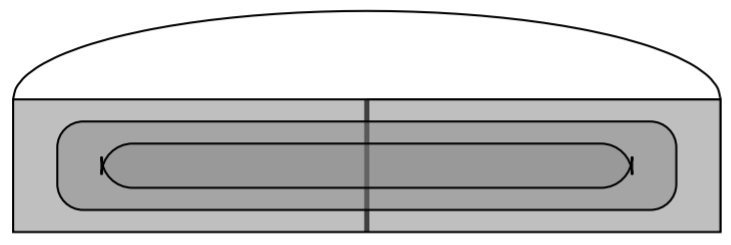
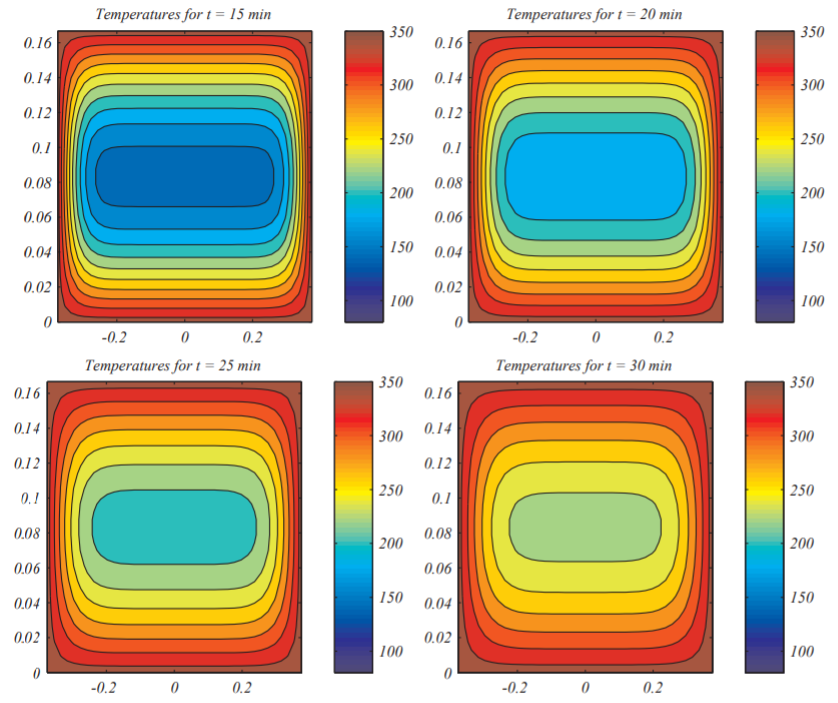
Again, one could generalize this example to considerations of other types of cakes with cylindrical symmetry. For example, there are muffins, Boston steamed bread which is steamed in tall cylindrical cans. One could also consider an annular pan, such as a bundt cake pan. In fact, such problems extend beyond baking cakes to possible heating molds in manufacturing.


